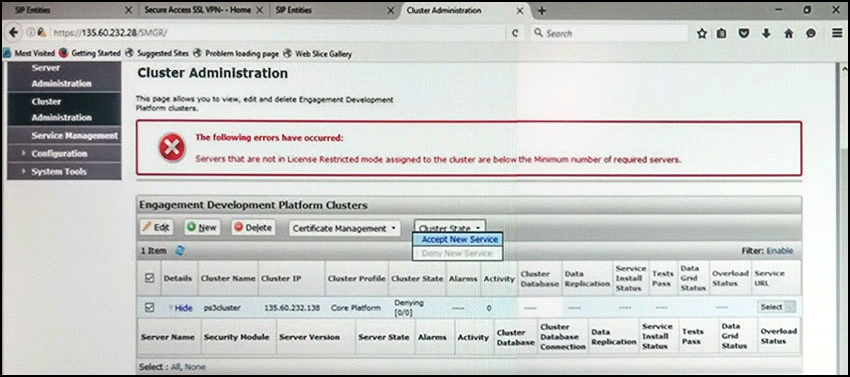Avaya Aura Communication Applications Support 72300X Exam Practice Test
Refer to the exhibit.

Refer to the exhibit.
In the Cluster Administration screen of a PresenceServices cluster, when you try to change the cluster state to Accept New Service, you receive the error:
Servers that are not in License Restricted mode assigned to the cluster are below the Minimum number of required servers.
You check that a server has been administered under Engagement Development Platform > Server Administration which shows green check under License Mode, and a System State of Denying.
Which action needs to be taken to solve this problem?
Answer : B
Which method can be used to verify the Client and TSAPI services have been administered correctly?
Answer : C
A customer reports that their Avaya Aura Communication Manager (CM) enabled SIP telephones (AST) can only see the effect of their telephone being Call Forwarded after they log off and log on again. Also stopping the call forward feature does not show until their endpoint is logged off and logged on again.
What is the cause of the problem?
Answer : C
When Avaya Session Border Controller for Enterprise (SBCE) initially receives the message from a SIP
endpoint wanting to update their Presence status, which operation does it perform?
Answer : B
A customer calls Avaya support because their 3rd party SIP telephones are not working. Support is able to confirm that the telephones are not supported and do not integrate with Communication Manager or Session Manager.
Which two pre-implementation steps were omitted? (Choose two.)
Answer : C, E
Which two trace tools are available for Session Manager? (Choose two.)
Answer : B, E
traceSBC is a tool that can be used to trace the calls that cross through the Avaya Session Border Controller (SBC), calls to the public network, or calls from the public network.
Which two statements describe another function of traceSBC? (Choose two.)
Answer : D, E